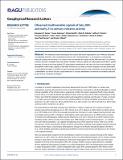Observed multivariable signals of late 20th and early 21st century volcanic activity
Author(s)
Santer, Benjamin D.; Solomon, Susan; Zelinka, Mark D.; Painter, Jeffrey F.; Beltran, Francisco; Fyfe, John C.; Johannesson, Gardar; Mears, Carl A.; Vernier, Jean-Paul; Wentz, Frank J.; Ridley, David Andrew; Bonfils, Celine; ... Show more Show less
DownloadSolomon_Observed multivatiable.pdf (1.451Mb)
PUBLISHER_POLICY
Publisher Policy
Article is made available in accordance with the publisher's policy and may be subject to US copyright law. Please refer to the publisher's site for terms of use.
Terms of use
Metadata
Show full item recordAbstract
The relatively muted warming of the surface and lower troposphere since 1998 has attracted considerable attention. One contributory factor to this “warming hiatus” is an increase in volcanically induced cooling over the early 21st century. Here we identify the signals of late 20th and early 21st century volcanic activity in multiple observed climate variables. Volcanic signals are statistically discernible in spatial averages of tropical and near-global SST, tropospheric temperature, net clear-sky short-wave radiation, and atmospheric water vapor. Signals of late 20th and early 21st century volcanic eruptions are also detectable in near-global averages of rainfall. In tropical average rainfall, however, only a Pinatubo-caused drying signal is identifiable. Successful volcanic signal detection is critically dependent on removal of variability induced by the El Nino–Southern Oscillation.
Date issued
2015-01Department
Massachusetts Institute of Technology. Department of Civil and Environmental Engineering; Massachusetts Institute of Technology. Department of Earth, Atmospheric, and Planetary SciencesJournal
Geophysical Research Letters
Publisher
American Geophysical Union (AGU)
Citation
Santer, Benjamin D., Susan Solomon, Celine Bonfils, Mark D. Zelinka, Jeffrey F. Painter, Francisco Beltran, John C. Fyfe, et al. “Observed Multivariable Signals of Late 20th and Early 21st Century Volcanic Activity.” Geophysical Research Letters 42, no. 2 (January 20, 2015): 500–509. © 2014 American Geophysical Union
Version: Final published version
ISSN
00948276